Abstract
Opsonic fibronectin is known to modulate macrophage (RE cell) and neutrophil Phagocytic function. Its depletion has been documented following trauma, burn, and operation in patients with rapid restoration of normal levels unless bacteremia and/or wound sepsis intervenes. Sepsis is associated with a secondary phase of opsonic fibronectin deficiency. We have observed in burn patients that this secondary phase of opsonic fibronectin depletion following trauma and burn is seen two to three days prior to the onset of clinical sepsis, raising the question of whether this deficiency sensitized the host to the subsequent development of sepsis or whether its deplection was merely an unsuspected sensitive indication of preclinical sepsis. To address the possibility that opsonic fibronectin deficiency might lower resistance to sepsis, Sprague-Dawley rats (200 gm) were partially depleted (35%) of their opsonic fibronectin prior to intraperitoneal inoculation with Staphylococcus aureus. Mortality to S. aureus peritonitis was significantly (p < 0.05) increased in animals with fibronectin deficiency. Furthermore, in control animals, nonsurvival was also associated with significantly (p < 0.05) lower initial fibronectin levels than survival. However, peritonitis itself also resulted in an early (within one hour) depletion of opsonic fibronectin followed by a marked “hyperopsonemia” within 12 hours in both groups. Thus, opsonic fibronectin depletion decreases resistance to sepsis, and the development of sepsis itself will initiate opsonic fibronectin deficiency. Host defense against infection may depend on early restoration and maintenance of normal opsonic fibronectin levels following trauma, burn, and operation, as well as the ability of the host to mount an appropriate hyperopsonemic elevation of fibronectin levels in response to infection.
Full text
PDF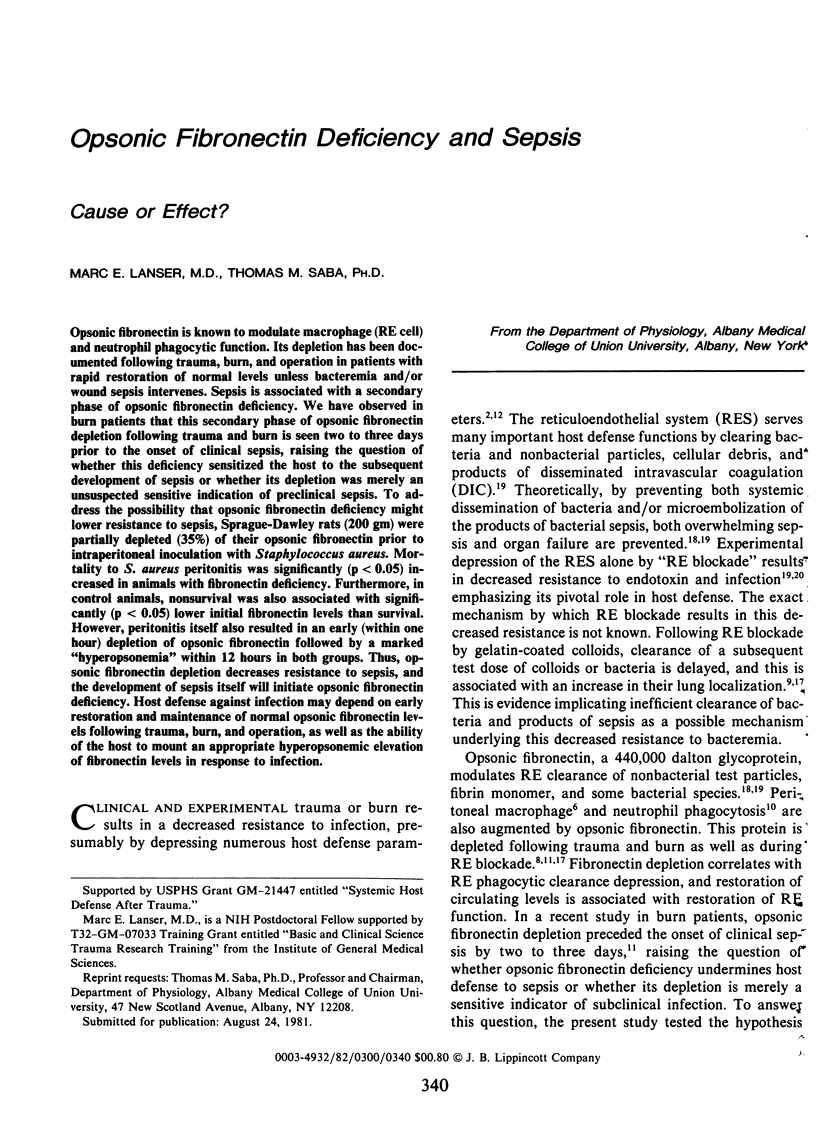
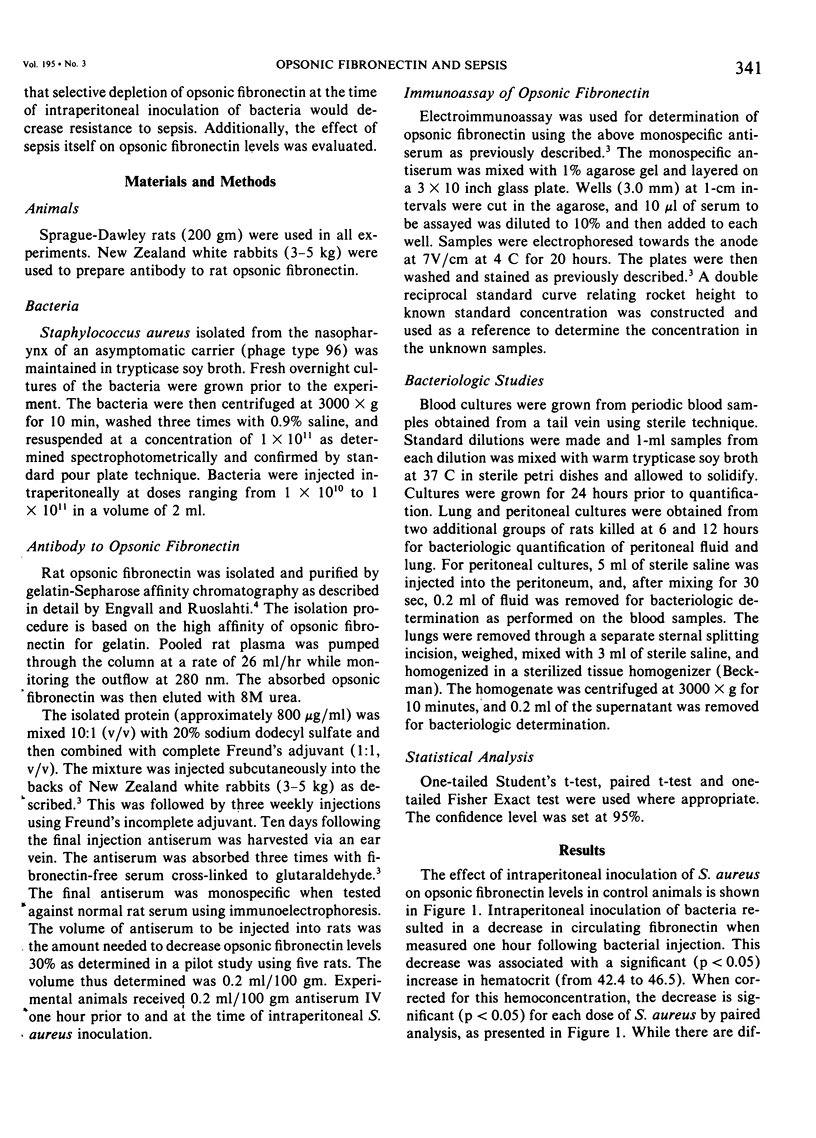
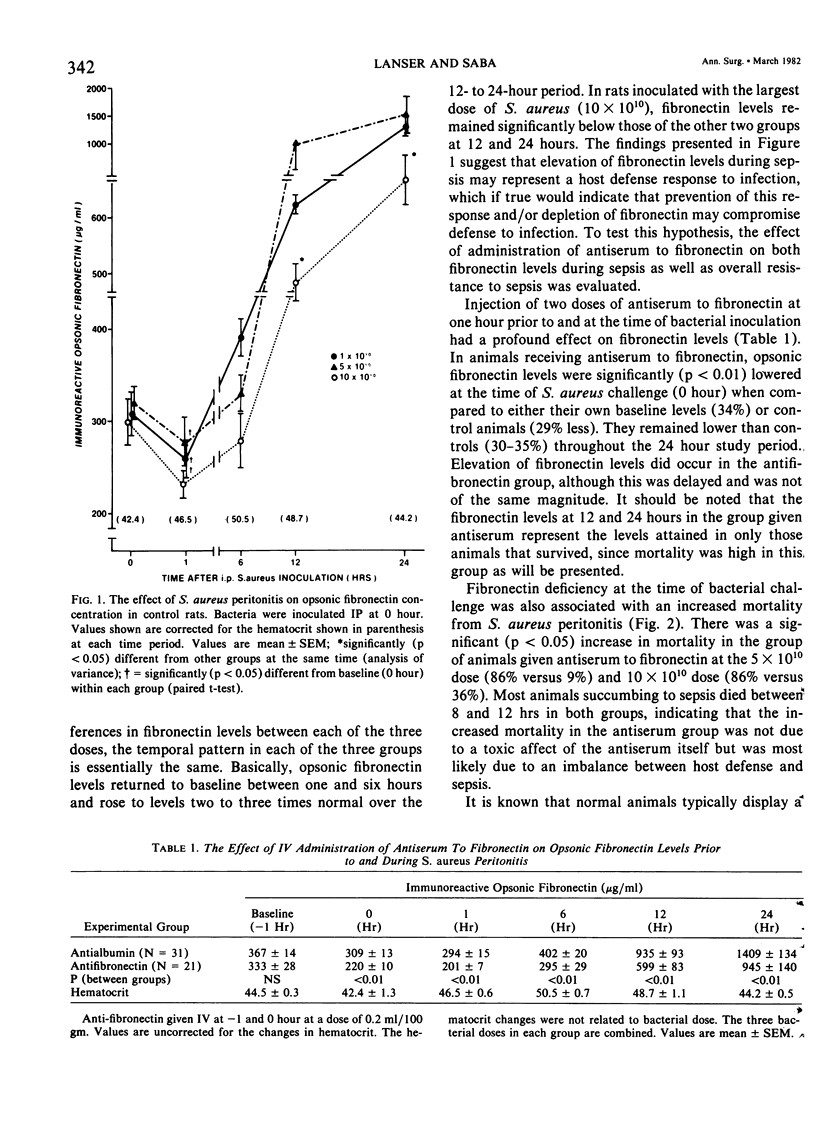

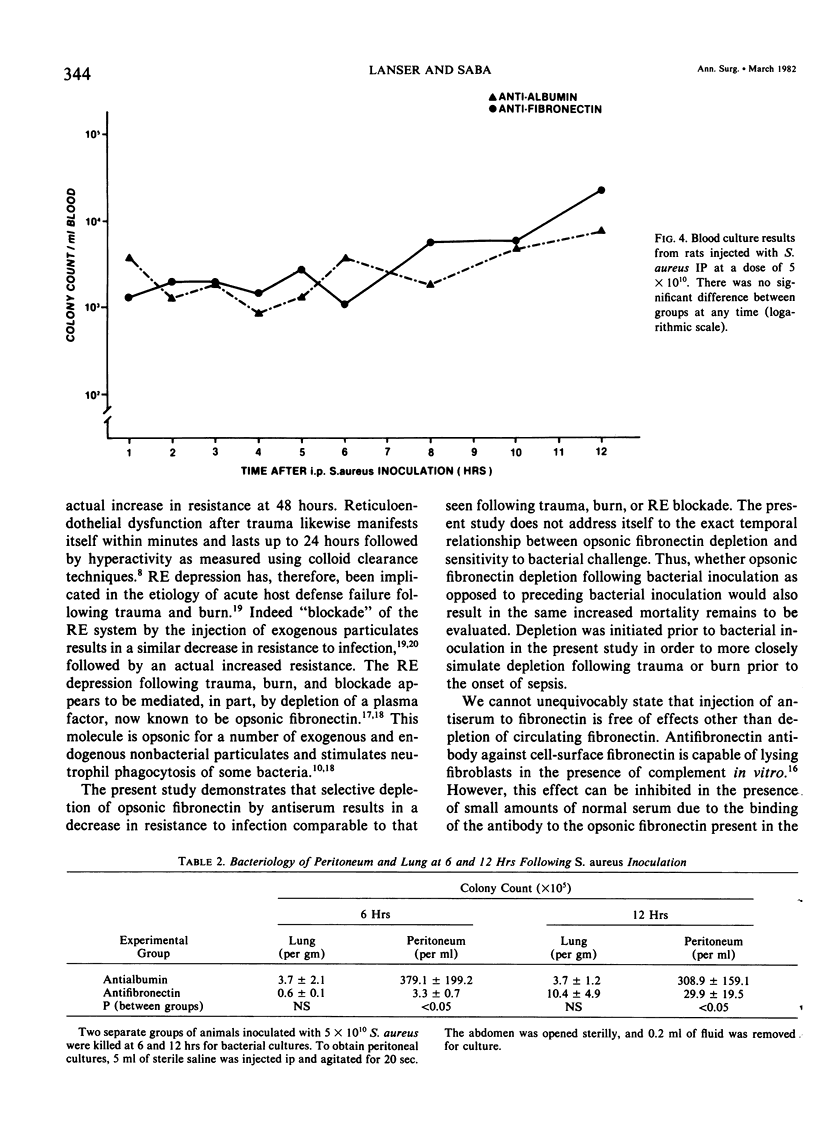
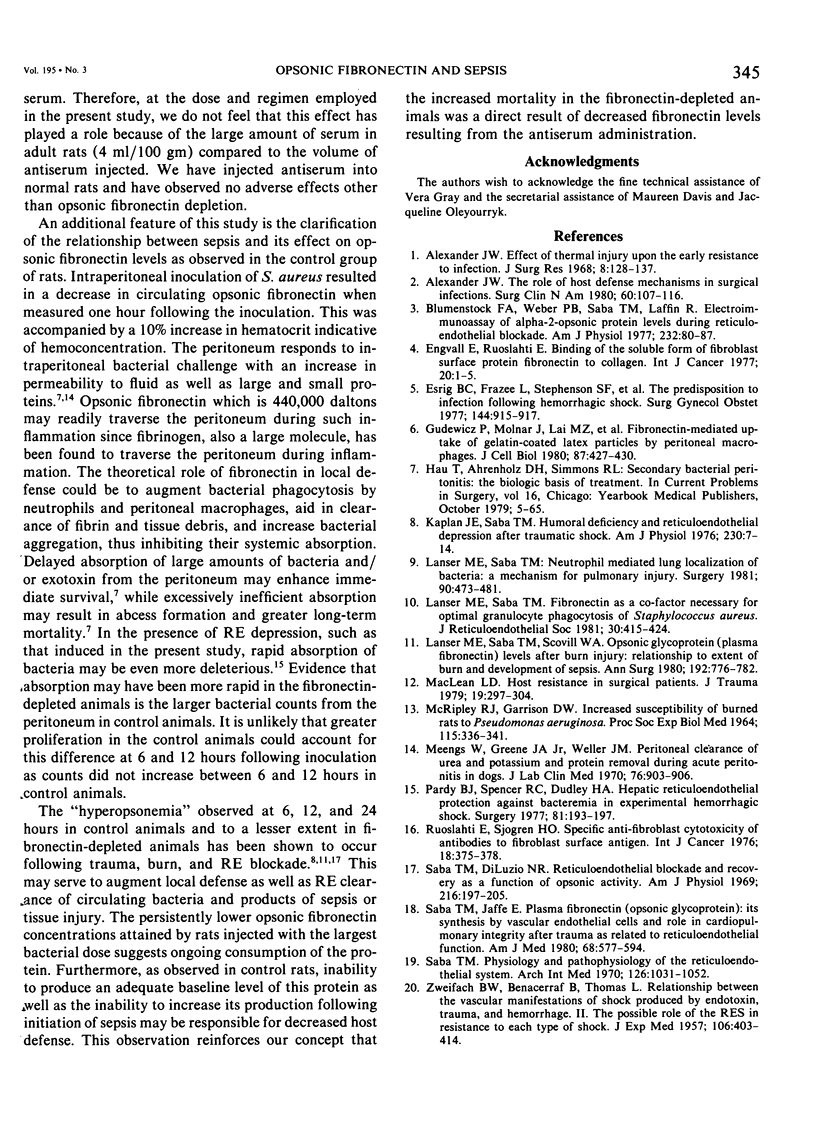
Selected References
These references are in PubMed. This may not be the complete list of references from this article.
- Alexander J. W. Effect of thermal injury upon the early resistance to infection. J Surg Res. 1968 Mar;8(3):128–137. doi: 10.1016/0022-4804(68)90074-7. [DOI] [PubMed] [Google Scholar]
- Alexander J. W. The role of host defense mechanisms in surgical infections. Surg Clin North Am. 1980 Feb;60(1):107–116. doi: 10.1016/s0039-6109(16)42037-2. [DOI] [PubMed] [Google Scholar]
- Engvall E., Ruoslahti E. Binding of soluble form of fibroblast surface protein, fibronectin, to collagen. Int J Cancer. 1977 Jul 15;20(1):1–5. doi: 10.1002/ijc.2910200102. [DOI] [PubMed] [Google Scholar]
- Esrig B. C., Frazee L., Stephenson S. F., Polk H. C., Jr, Fulton R. L., Jones C. E. The predisposition to infection following hemorrhagic shock. Surg Gynecol Obstet. 1977 Jun;144(6):915–917. [PubMed] [Google Scholar]
- Gudewicz P. W., Molnar J., Lai M. Z., Beezhold D. W., Siefring G. E., Jr, Credo R. B., Lorand L. Fibronectin-mediated uptake of gelatin-coated latex particles by peritoneal macrophages. J Cell Biol. 1980 Nov;87(2 Pt 1):427–433. doi: 10.1083/jcb.87.2.427. [DOI] [PMC free article] [PubMed] [Google Scholar]
- Kaplan J. E., Saba T. M. Humoral deficiency and reticuloendothelial depression after traumatic shock. Am J Physiol. 1976 Jan;230(1):7–14. doi: 10.1152/ajplegacy.1976.230.1.7. [DOI] [PubMed] [Google Scholar]
- Lanser M. E., Saba T. M. Fibronectin as a co-factor necessary for optimal granulocyte phagocytosis of Staphylococcus aureus. J Reticuloendothel Soc. 1981 Nov;30(5):415–424. [PubMed] [Google Scholar]
- Lanser M. E., Saba T. M. Neutrophil-mediated lung localization of bacteria: a mechanism for pulmonary injury. Surgery. 1981 Sep;90(3):473–481. [PubMed] [Google Scholar]
- Lanser M. E., Saba T. M., Scovill W. A. Opsonic glycoprotein (plasma fibronectin) levels after burn injury. Relationship to extent of burn and development of sepsis. Ann Surg. 1980 Dec;192(6):776–782. doi: 10.1097/00000658-198012000-00014. [DOI] [PMC free article] [PubMed] [Google Scholar]
- MCRIPLEY R. J., GARRISON D. W. INCREASED SUSCEPTIBILITY OF BURNED RATS TO PSEUDOMONAS AERUGINOSA. Proc Soc Exp Biol Med. 1964 Feb;115:336–338. doi: 10.3181/00379727-115-28906. [DOI] [PubMed] [Google Scholar]
- MacLean L. D. Host resistance in surgical patients. J Trauma. 1979 May;19(5):297–304. doi: 10.1097/00005373-197905000-00001. [DOI] [PubMed] [Google Scholar]
- Meengs W., Greene J. A., Jr, Weller J. M. Peritoneal clearance of urea and potassium and protein removal during acute peritonitis in dogs. J Lab Clin Med. 1970 Dec;76(6):903–906. [PubMed] [Google Scholar]
- Pardy B. J., Spencer R. C., Dudley H. A. Hepatic reticuloendothelial protection against bacteremia in experimental hemorrhagic shock. Surgery. 1977 Feb;81(2):193–197. [PubMed] [Google Scholar]
- Ruoslahti E., Sjögren H. O. Specific anti-fibroblast cytotoxicity of antibodies to fibroblast surface antigen. Int J Cancer. 1976 Sep 15;18(3):375–378. doi: 10.1002/ijc.2910180317. [DOI] [PMC free article] [PubMed] [Google Scholar]
- Saba T. M., Di Luzio N. R. Reticuloendothelial blockade and recovery as a function of opsonic activity. Am J Physiol. 1969 Jan;216(1):197–205. doi: 10.1152/ajplegacy.1969.216.1.197. [DOI] [PubMed] [Google Scholar]
- Saba T. M., Jaffe E. Plasma fibronectin (opsonic glycoprotein): its synthesis by vascular endothelial cells and role in cardiopulmonary integrity after trauma as related to reticuloendothelial function. Am J Med. 1980 Apr;68(4):577–594. doi: 10.1016/0002-9343(80)90310-1. [DOI] [PubMed] [Google Scholar]
- Saba T. M. Physiology and physiopathology of the reticuloendothelial system. Arch Intern Med. 1970 Dec;126(6):1031–1052. [PubMed] [Google Scholar]
- ZWEIFACH B. W., BENACERRAF B., THOMAS L. The relationship between the vascular manifestations of shock produced by endotoxin, trauma, and hemorrhage. II. The possible role of the reticulo-endothelial system in resistance to each type of shock. J Exp Med. 1957 Sep 1;106(3):403–414. doi: 10.1084/jem.106.3.403. [DOI] [PMC free article] [PubMed] [Google Scholar]


